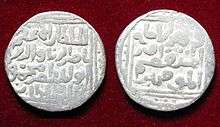Nasiruddin Mahmud (grandson of Iltutmish)
Nasir ud din Mahmud, Nasir ud din Firuz Shah (reigned: 1246–1266) was the eighth sultan of the Mamluk Sultanate (Slave dynasty). He was the grandson of Shams ud din Iltutmish (1211–36), and ascended to the throne of Delhi Sultanate in 1246 at the tender age of 17 or 18 after the disposition of Masud Shah.[2] He succeeded Ala ud din Masud after the chiefs replaced Masud when they felt that he began to behave as a tyrant.
| Nasir-ud-din Mahmud | |
|---|---|
| Sultan of Delhi | |
 Coin of Nasir ud Din Mahmud | |
| Reign | 10 June 1246 – 18 February 1266 |
| Coronation | 10 June 1246 in Delhi |
| Predecessor | Ala ud din Masud |
| Successor | Ghiyasuddin Balban |
| Born | 1229 or 1230 |
| Died | 18 February 1266 |
| Burial | Space |
| Issue | A daughter |
| House | Mamluk Dynasty (Delhi) |
| Father | Nasiruddin Mahmud (son of Iltutmish) |
| Mother | Malika-i-Jahan[1] |
As a ruler, Mahmud was known to be very religious, spending most of his time in prayer and copying the Quran. However, it was actually his father-in-law and Deputy Sultan or Naib, Ghiyas ud din Balban, who primarily dealt with the state affairs.[3]
After Mahmud's death in 1266, Balban (1266–87) rose to power as Mahmud had no children to be his heir.
Personal life
Unlike many of his predecessors and successors, Mahmud strictly followed monogamy. He spent most of his time writing down verses of the Quran. He sold the handwritten copies and used the money for his personal expenses. Surprising enough, he had no servants to carry out his personal tasks. His wife had to cook the food for the family.[4]
See also
- Mamluk dynasty
- History of India
- Islamic history
- List of Indian monarchs
References
- Mehta, Jaswant Lal (1980). Advanced Study in the History of Medieval India. Sterling Publishers Pvt. Ltd. p. 105, n. 29. ISBN 9788120706170.
- Sen, Sailendra (2013). A Textbook of Medieval Indian History. Primus Books. pp. 74–76. ISBN 978-9-38060-734-4.
- Vandhargal Vendrargal. Chennai: Vikatan Prasuram. 2012. p. 27. ISBN 81-89780-59-X.
External links
| Preceded by Ala ud din Masud |
Mamluk Dynasty 1206–1290 |
Succeeded by Ghiyas ud din Balban |
| Preceded by Ala ud din Masud |
Sultan of Delhi 1246–1266 |
Succeeded by Ghiyas ud din Balban |